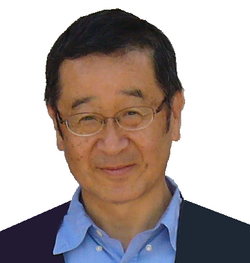Biography:Yoshihisa Yamamoto (scientist)
Yoshihisa Yamamoto | |
|---|---|
 | |
| Born | November 21, 1950 (age 73)[1] |
| Citizenship | Japan[2] |
| Alma mater | Tokyo Institute of Technology[1][3]
University of Tokyo[1][3] |
| Known for | Quantum-dot single-photon sources;[4] Differential phase-shift quantum key distribution; Quantum-dot spin qubits;[5] Exciton-polaritons.[6] |
| Awards | Medal of Honour with Purple Ribbon.[2]
Nishina Memorial Prize (1992)[7] |
| Scientific career | |
| Doctoral advisor | Hisayoshi Yanai;[8] Takeshi Kamiya[8] |
| Other academic advisors | Yasuharu Suematsu[8] |
| Doctoral students | Isaac Chuang[9] (MIT); Charles Santori (Verily) |
| Other notable students | Joseph Jacobson (MIT) |
Yoshihisa Yamamoto (山本 喜久 Yamamoto Yoshihisa) is a scientist and engineer and winner of the Medal of Honour with Purple Ribbon.[2][10]
Biography
Yamamoto was born in Tokyo on November 21, 1950.[1] In 1973 he got his B.S. degree from the Tokyo Institute of Technology.[1][3] He continued his studies at the University of Tokyo where he earned a M.S. in 1975 and a Ph.D. in 1978.[1][3] Since 1992 he is a professor of applied physics and electrical engineering at Stanford University in the United States. Since 2003 he also has professorships at the University of Tokyo and the National Institute of Informatics in Tokyo.
Work
Yamamoto's scientific focuses in the 1980s were optical fiber communications, semiconductor lasers, quantum non-demolition measurement and quantum optical effects. His most prominent work in the 1990s is in semiconductor quantum optics (especially involving microcavities and quantum wells) and quantum effects and noise in electronic devices.[11]
During the 2000s, his most prominent work was on the development of optically-active quantum dots as a platform for quantum information processing (both as single-photon sources for quantum cryptography, and as hosts for spin qubits), and his work on exciton-polaritons,.[12][6] Yamamoto was also active in the development of both theory and realization of quantum key distribution protocols. Landmark papers from this era include the demonstration of indistinguishable photons from a single quantum dot;[4] the proposal for biexciton cascade as a method for generating entangled photons (for QKD) from a single quantum dot [13] (this is the proposal underlying essentially all QD entangled-photon sources, such as those reviewed in [14]), and demonstration of control of a single spin qubit in a quantum dot using optical pulses.[15]
During the 2010s, his work has continued on exploring quantum dots as a platform for building both quantum repeaters and quantum computers. One highlight was the co-first demonstration (with Ataç İmamoğlu's group) of entanglement between a spin in a quantum dot and a photon emitted by it.[16] Work on exciton-polaritons continued, and since 2012, Yamamoto has pioneered the development of an optical computer,[17] inspired by developments in quantum annealing and adiabatic quantum computing.
References
- ↑ 1.0 1.1 1.2 1.3 1.4 1.5 1.6 Y. Yamamoto, et al., "Theory of a negative frequency feedback semiconductor laser," IEEE Journal of Quantum Electronics, vol.21, no.12, pp. 1919–1928, Dec 1985
- ↑ 2.0 2.1 2.2 David Orenstein: Quantum research earns medal from Japanese emperor. Dated 2005-11-18. Original at stanford.edu, , Archived copy at WebCite
- ↑ 3.0 3.1 3.2 3.3 Yamamoto: Introduction of researcher. Dated 2004-09-10. Original at nii.ac.jp,
- ↑ 4.0 4.1 Santori Charles (2002). "Indistinguishable photons from a single-photon device". Nature 419: 594–597. doi:10.1038/nature01086. Bibcode: 2002Natur.419..187L.
- ↑ Theory Jones N. Cody, Van Meter Rodney, Fowler Austin G., McMahon Peter L., Kim Jungsang, Ladd Thaddeus D., Yamamoto Yoshihisa (2012). "Layered Architecture for Quantum Computing". Physical Review X 2. doi:10.1103/PhysRevX.2.031007. Bibcode: 2012PhRvX...2c1007J. and experiment De Greve Kristiaan (2013). "Ultrafast optical control of individual quantum dot spin qubits". Reports on Progress in Physics 76: 092501. doi:10.1088/0034-4885/76/9/092501. Bibcode: 2013RPPh...76i2501D..
- ↑ 6.0 6.1 Byrnes Tim (2014). "Exciton–polariton condensates". Nature Physics 10: 803–813. doi:10.1038/nphys3143. Bibcode: 2014NatPh..10..803B.
- ↑ Nishihna Memorial Foundation: Recipients of Nishina Memorial Prizes. Retrieved on 2012-11-15. Nishina Original at nishina-mf.or.jp.
- ↑ 8.0 8.1 8.2 Yoshihisa Yamamoto (January 2005). "Curriculum Vitae". Archived from the original on July 18, 2010. https://web.archive.org/web/20100718210850/http://appliedphysics.stanford.edu/cv/Yamamoto.pdf. Retrieved March 28, 2014.
- ↑ Yoshihisa Yamamoto: Group members. Retrieved on 2012-10-22. Original at stanford.edu, ,
- ↑ NII News: Professor Yoshihisa YAMAMOTO is awarded "Medal with Purple Ribbon". Dated 2005-11-02. Original at nii.ac.jp, ,
- ↑ Oliver W. D. (1999). "Hanbury Brown and Twiss-Type Experiment with Electrons". Science 284: 299–301. doi:10.1126/science.284.5412.299. Bibcode: 1999Sci...284..299O.
- ↑ Deng Hui (2010). "Exciton-polariton Bose-Einstein condensation". Reviews of Modern Physics 82: 1489–1537. doi:10.1103/RevModPhys.82.1489. Bibcode: 2010RvMP...82.1489D.
- ↑ Benson Oliver, Santori Charles, Pelton Matthew, Yamamoto Yoshihisa (2000). "Regulated and Entangled Photons from a Single Quantum Dot". Physical Review Letters 84: 2513–2516. doi:10.1103/PhysRevLett.84.2513. Bibcode: 2000PhRvL..84.2513B.
- ↑ Shields Andrew J (2007). "Semiconductor quantum light sources". Nature Photonics 1: 215–223. doi:10.1038/nphoton.2007.46. Bibcode: 2007NaPho...1..215S.
- ↑ Press David, Ladd Thaddeus D., Zhang Bingyang, Yamamoto Yoshihisa (2008). "Complete quantum control of a single quantum dot spin using ultrafast optical pulses". Nature 456: 218–221. doi:10.1038/nature07530. Bibcode: 2008Natur.456..218P.
- ↑ De Greve Kristiaan (2012). "Quantum-dot spin–photon entanglement via frequency downconversion to telecom wavelength". Nature 491: 421–425. doi:10.1038/nature11577. Bibcode: 2012Natur.491..421D.
- ↑ McMahon Peter L., Marandi Alireza, Haribara Yoshitaka, Hamerly Ryan, Langrock Carsten, Tamate Shuhei, Inagaki Takahiro, Takesue Hiroki, Utsunomiya Shoko, Aihara Kazuyuki, Byer Robert L., Fejer M. M., Mabuchi Hideo, Yamamoto Yoshihisa (2016). "A fully programmable 100-spin coherent Ising machine with all-to-all connections". Science 354: 614–617. doi:10.1126/science.aah5178. Bibcode: 2016Sci...354..614M.

